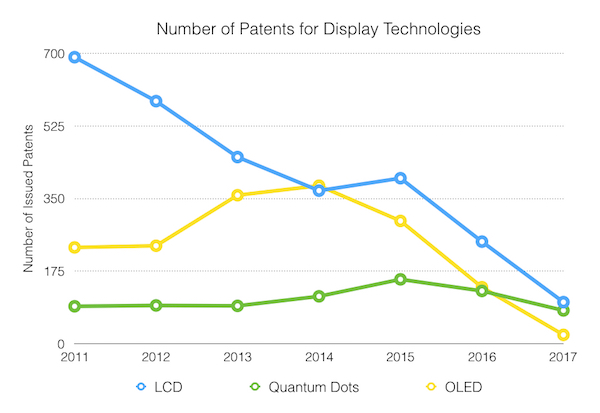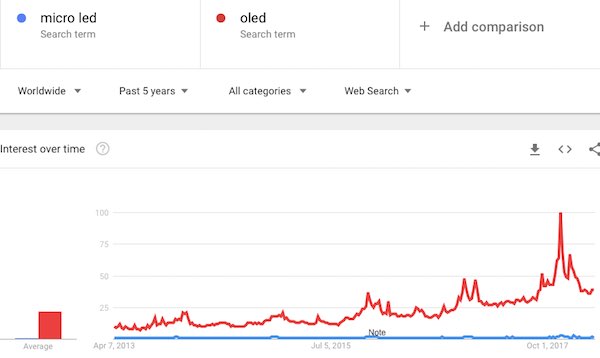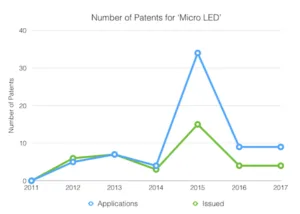In recent months the rumors about Apple and micro LEDs have been indicating an increased activity of developing this technology further. Besides Apple’s top management, nobody really knows what they are planning, but this would not stop the stream of new rumors anyway. As a matter of fact, it may actually increase the number of articles around the world, including this one.

What we know or at least believe we know
After the acquisition of LuxVue in 2014, Apple has gone very quiet on this technology. Every year, someone brings up the possibility that Apple may actually use this screen technology in the next announcement of the newest revision of their Apple Watch, iPhone, iPad, Macbook, etc. In all of these cases this was just a shot into the dark that was never confirmed or even commented on by Apple. As far as Apple goes, this is pretty much standard procedure.
A few weeks ago Apple Insider announced a ‘secret facility’ in silicon valley near the Apple headquarter where 300 engineers develop this new technology. They speculated that the new displays will be most likely to enter the market in the Apple Watch. They also quote their sources saying that Apple produced the first display matching the Apple Watch format late in 2017 and is now capable of producing a few displays at a time.
 AppleInsider Micro LED Fab
AppleInsider Micro LED Fab
Now Digitimes comes forward with a report that TSMC (Taiwan Semiconductor Manufacturing Company) is working with Apple in developing backplanes for small sized displays. They also mention that Apple is developing TFT backplanes for larger sized displays exceeding the form factor of a Macbook. Based on their sources, Digitime’s analyst Luke Lin also said that the new display may be used for AR wearable devices, potentially AR glasses.
As you can see, all these ‘facts’ are laced with assumptions about the status of the development of this new technology. To derive from such activities that Apple will actually release a product in 2018 or the coming year is very risky, if accuracy of the published assumptions is of any importance.
We do write regularly about micro LED displays and I personally believe that this technology does have a good chance as an alternative to OLED displays. Both, micro LED and OLED have their own sets of challenges and both promise to create more power efficient high performance displays. Together with the event of quantum dots entering the market, we have the situation that new technologies are enabling established display technologies such as LCD and OLED (yes, I count them as an established display technology) to push the boundaries of image quality into new territory. So question is, who will be the winner?
What can we realistically expect?
Historically new technologies offered substantial display improvements for certain applications (i.e. LCD for the notebook) and often enabling new devices. Could you imagine a smartphone with a CRT? They often came with a price premium that quickly dissipated. However, it seemed that for one application there was always one winner, even if it took a decade or longer to push out other technologies completely. Are we still making CRT TVs anywhere in the world?
On the other hand, a new display technology like microLED could be creating a disruptive market environment if there is a competitive advantage over established display technologies. In the display world this typically means make a better display cheaper than the other guy. For microLED this means high brightness at better power efficiency, which would fit the bill for mobile applications. However, the price part doesn’t seem to fit the bill today. There is a significant price differential from microLED to OLED and LCD today. Once this can be overcome, the mass market will switch over, until then, niche markets are the best approach for micro LED.
Another factor is the effort one has to put in for a new display technology to become successful in mass markets. This effort can be measured in terms of patents covering such new field. When we take a look at the number of US patent applications and issued patents covering this field we get an idea that there isn’t a lot going on in micro LED technology. We searched for the term ‘ Micro LED’ in the patent abstract, which should bring up most of the relevant patents.
On the other hand the number of patents for other display technologies are much higher. Nevertheless there is the peculiar trend of a decreasing number of display patents being issued since 2014. Has the patent protection lost its value in our industry?

Since MicroLED is the hot new technology in the display world I also looked at the web search activity of Micro LED versus OLED. It came as no surprise that it seems the only people searching for Micro LED is us analysts. The wider population has still to be introduced to the potentially best new display technology.
 MicroLed vs OLED for Google search terms
MicroLed vs OLED for Google search terms
What does this all mean?
When we compare the interest and effort for other display technologies there seems to be no comparison to MicroLED today. It is difficult to believe that MicroLED will play a major role in the display industry with this very low number of issued patents. This is, of course, only true if we are not seeing a drastic shift how the display industry views patent protection today. This is a very interesting topic in itself.
The interest of the general population in Micro LED is almost not existent today. If Apple could pull this new display technology into the limelight in this year, it would surprise not only most analysts, but all the world population in general. My best bet is that this is not going to happen, development by Apple – yes, like many other CE companies do. – NH

